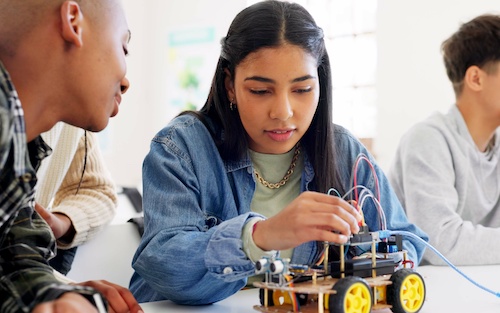Key points:
When it comes to post-pandemic academic recovery, much discussion centers on math and reading–but science learning losses are lingering, with some groups disproportionately impacted.
A new research report from NWEA, a K-12 assessment and research organization, explores trends in science achievement since the start of the COVID-19 pandemic. Using MAP Growth assessment results for grades three to eight, NWEA researchers found a mixed story of academic recovery.
Similar to earlier research into math and reading, science achievement dropped early in the pandemic. Unlike pandemic-related math and reading achievement, science achievement in grades three through five has returned to near pre-COVID levels while middle school grades, specifically seventh and eighth grades, continue to show signs of a struggling recovery.
“The trends tell a slightly different story than what we’ve seen in math and reading,” said Sue Kowalski, Lead Research Scientist at NWEA. “On the one hand, our elementary students are nearly back to pre-pandemic academic growth and achievement for science, but our older students are still very much struggling.”
The new report is the latest in a series of research from NWEA examining the impacts of the pandemic on academic gains and achievement in the U.S. This report analyzed data from 621 U.S. public schools that consistently administered the MAP Growth Science assessment from spring 2017 through spring 2024 and consistently tested the same grades within those schools.
“Science learning losses are smaller than losses in reading and math. To contextualize losses in science, the report’s authors compared months of additional learning required to catch up across reading, math, and science. Lewis and Kuhfeld (2024) found larger achievement gaps across all grades in reading and math, with up to 9.0 months lost in reading, and up to 9.3 months lost in math. By comparison, the average achievement gaps for science are modest (up to 3.2 months lost in science),” according to the report.
“But the modest averages, particularly in middle school, belie the serious needs of Black and Hispanic middle school students in science. Hispanic eighth-grade students were five months behind in 2021 and fell to a total of more than 11 months behind by 2024. Black middle school students rebounded by 2024 to preCOVID achievement levels but remain 13 to 15 months behind,” the authors noted.
Key findings include:
- COVID-19 school closures caused science achievement to drop early in the pandemic, resulting in one to 2.3 months of unfinished learning by spring 2021.
- There is evidence of uneven recovery in science achievement across the elementary and middle grades by spring 2024. Science achievement returned to near-2019 levels for grades three through five but continued to decline for grades seven and eight. Achievement gaps for sixth graders decreased by 2024, but the reduction was smaller than that for grades 3-5.
- The most significant declines are evident for 8th graders, who are approximately 3.2 months behind. This was true for students from all racial/ethnic groups, but in 2024, Hispanic students are farthest behind their 2019 peers, and Black students remain far below the overall 2019 mean despite rebounding.
“This is a first large-scale look into trends in science achievement, and while there are some differences compared to trends in reading and math, one area continues to raise concerns, and that’s the lingering impacts for eighth graders,” added Kowalski. “This is particularly problematic if not addressed, given the increasing complexity of science content they are about to encounter in high school.”
The research report provided several recommendations to education leaders on addressing this uneven recovery, including more integration of science into other subjects and continued usage of summer programming provided to students who need it most.


